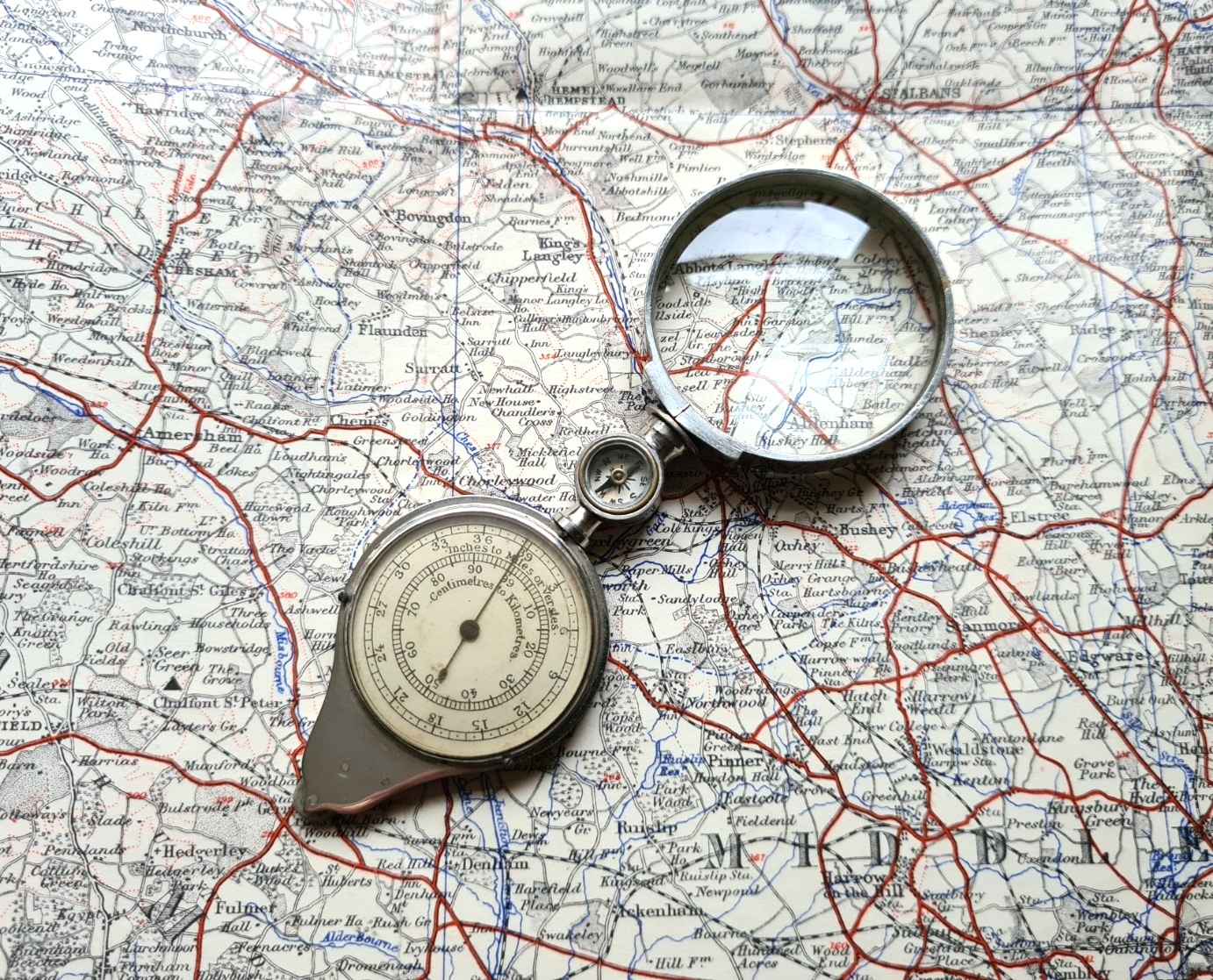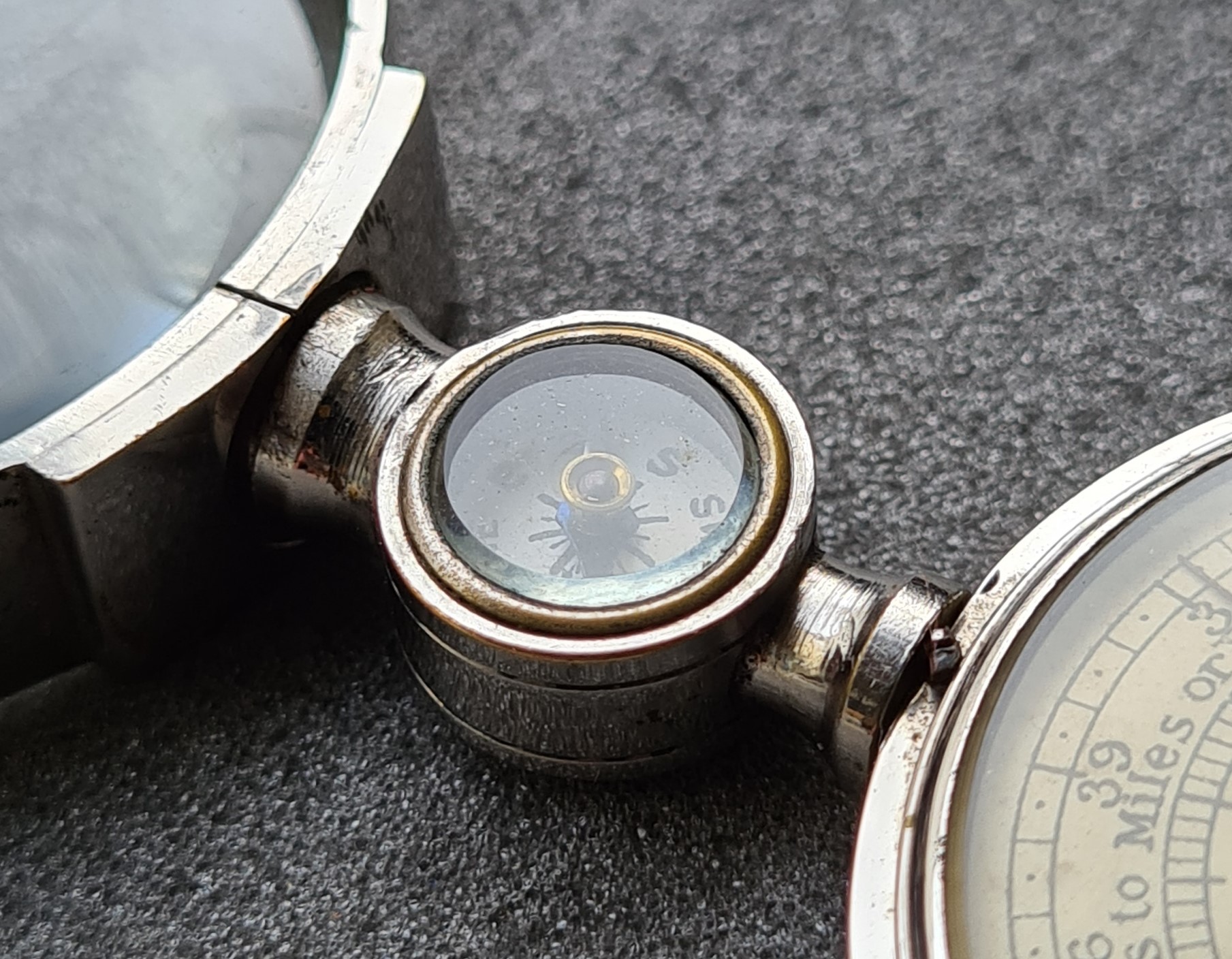This instrument is based around an effective curvimetre from one of the most prolific of French manufacturers. As an attempt to combine three useful functions, it largely fails.
The measure itself is a version of the model 56 ‘Universal’ curvimetre, an “automatic measurer” manufactured by both Henri Chatelain (French) and Fritz Chatelain (Swiss) instrument makers from the 1870s through to the mid-twentieth century. French based Henri Chatelain was born 2 July 1848 and his manufacturing business was founded in the late 1870s (variously 1876 or 1878). The business later worked out of 10 Rue de Belzunce, Paris, France and the first mention of Henri Chatelain making curvimetres from this address appears in the French trade directory Didot-Bottin in 1887. This month’s measure is illustrated in Henri Chatelain’s 1907 catalogue. This newly introduced measure is variously listed as: “New Patent English Map Measurers“, “Curvimètres en Mesures Russes” (Curvimeters in Russian Measurements), and “Curvimètres a echelles métriques” (Curvimeters with Metric Scales). Our measure’s scales appear to be a combination of all three, with miles, verstes and kilometres shown.
The HC company name was active until the 1920s, however around 1898, the name Fritz-Chatelain had become more prevalent in relation to the Swiss versions of the curvimetre. HC appears to be, by far, the identifier found on most earlier surviving examples of this type of measure. Henri Chatelain died 1 June 1921.
The glass faced measure has one dial face with two concentric scales. The inner dial indicates Centimetres to Kilometres, measuring 0-99, divided into tenths with single cm/km increments. The outer scale converts Inches to Miles or Verstes (1 verste = 0.662879 mile). This obsolete Russian measurement was only included on earlier map measures and largely excluded from the turn of the century. The inch dial measures from 0-39, with every three inches shown. There are further increments of single inches.
The rear of the polished nickel case has the HC logo. This is comprised of the letters HC above a curvimetre, cleverly centred on one of the pins around which the internal gearing mechanism rotates. The word Déposé above the trademark is not part of the trademark but simply indicates that the manufacturer had registered the design.
The measure has a flat crystal faced compass between measuring dial and magnifier. This is a very small compass and of limited practical use. It is a press fit into its plain backed housing. The compass has an external diameter of 11.8mm to its surround and a diameter of 8.5mm surrounding the internal compass dial. Cardinal and intercardinal points are included with small secondary intercardinal points also shown. Unsurprisingly, the compass is not liquid filled, but the needle does indicate north. This lack of damping does mean the needle wavers considerably when moved but it does settle down if rested on a surface.

“… with a powerful reading glass for examining small print on maps”
Chatelain model A797 descriptor
Described by Chatelain as a ‘reading glass’, the magnifying glass is quite large, 39mm across. It is a simple glass lens and works adequately well for simply enlarging finer print and detail in a newspaper, book, map or similar, however there is some distortion due to the single lens design. The external diameter of the magnifier is 41.5mm, the external diameter of the measuring dial and case is 35.3mm and the length of the entire combination curvimetre, from the tip of the small tracking wheel to the top edge of the magnifier is 111.5mm. The measure weighs 57g.
Carefully made and constructed internal cogged mechanisms are common to all HC measures and it is unsurprising that this is an accurate measure. The Universal measure, produced by both Henri Chatelain and Fritz Chatelain, had a long life, testament to fine design and manufacture. However, this months instrument is a clumsy attempt at bringing together three functions- measure, compass and magnifier. It would be better if simply a dual function affair. A simple handle attached to the end of the compass would be a better balanced and more easily handled instrument. Despite this combination measurer/compass/magnifier appearing in the Chatelain 1904 catalogue, I doubt large numbers would have been sold.
HC manufactured many ‘automatic measurers’ over the years. The design of which most others were variants was their model 56, with the same measuring dial seen here. One of their range, model A797, was a measure with magnifying glass. This months measure is a further progression on that design. The whole measure appears to be very much a Frankenstein affair, bringing together disparate elements in an attempt to create a whole that is greater than its parts. In this, it mostly fails. Of most importance is that holding the magnifier while operating the measure makes it difficult to comfortably follow a line on a map. The compass is obviously also limited in practical application due to its small size. You may see in the top image that someone had added a modern stainless-steel washer to the section threaded onto the magnifier. This had presumably been added in order to orientate the glass magnifier correctly, possibly due to a worn or loose thread. This non-contemporaneous item is now removed. If I had been unaware of a 1907 catalogue listing of this instrument, the poor orientation of the magnifier and poor marrying of curved magnifier with tapered handle section may have added weight to an argument that the magnifying glass had replaced a plain handle originally mounted above the compass. Helpfully, the measure was accompanied by an accessory that also pointed at this being an original and intentional design- it has a bespoke case.
The measure has a frame purse with kiss lock, or ‘gamaguchi’. This word originates from the resemblance to the open mouth of a toad, “gama” meaning toad and “guchi” meaning mouth in Japanese. The shaped purse is wider at the mouth end to accommodate the wide magnifier, with narrow waist and a widened section for the measuring case beyond that. This bespoke purse is very obviously made for this specific combination measure, also borne out by contemporary advertising:
“in chamois leather bag which will keep the reading glass always clear”
The purse almost certainly originates from small volume local production in mainland Europe, directly commissioned by the Chatelain company. The metal frame closes a shaped-to-fit chamois leather case. This purse has a cream-coloured interior and what looks to be a now extensively age-faded pale green or blue exterior.
Three Points of the Compass has looked at a few more Map Measures in detail. Links to these can be found here.











